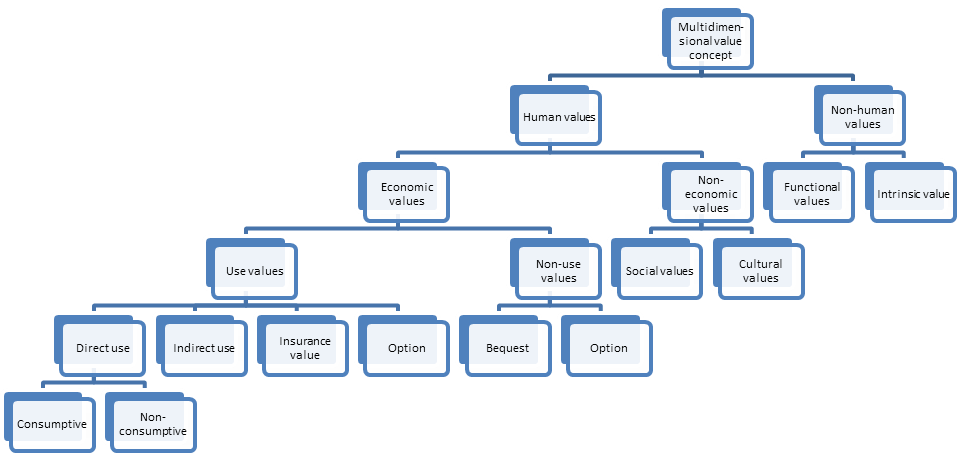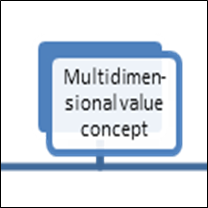![]() Intended audience
Intended audience
The intended audience of the brief are people working with or with an interest in land use management and related issues. The division of values into increasingly disaggregated categories provides the reader with a systematic and easy-to-read overview of a complicated issue, and hopefully it will serve to address some of the common misconceptions that may lead to conflict and confusion between stakeholders with different professional backgrounds. Hence, the brief may serve to make policy-makers, planners and others involved in land use management aware of the multitude and diversity of values and their interdependencies. This has relevance for the design of land use management strategies for multiple objectives.
Topic
There are many more or less similar classifications of values to be found in the literature, but none of them take a sufficiently wide perspective to fit the purpose of the present brief. Consequently, a new classification approach drawing on, and combining elements from, several other classifications is proposed. The rationale underlying the classification proposed here is that all types of value should be included on equal terms; hence, the classification should be true to the good being valued rather than reflect the professional discipline or personal interest of the person conducting the value assessment. The proposed classification scheme is presented in Figure 1. The total value of a given natural system is given by aggregation of values across all relevant sub-categories.

Following the multidimensional value concept depicted in Figure 1, a fundamental distinction is made between human and non-human values.
Non-human values are based on an assumption that natural systems possess inherent values, which are independent of humans’ preferences for the natural system and/or the services it provides. While non-human values in theory are independent of human preferences, they are not so in practice. Hence, any assessment of non-human values is bound to be human to some extent as humans are needed not only to make the actual assessment but also to decide which non-human values to include. In practice, non-human values are therefore not purely objective or free from human values.
In Figure 1 the non-human values are divided into two subcategories, namely functional value and intrinsic value. Functional values relate to purely technical, biological or physical relationships of one non-human entity to another. Intrinsic value, on the other hand, is unrelated to any services or functions provided by the object being valued; it represents the value which an object possess’ qua its mere existence.
Human values are used as a collective term for all values that are based on individuals’ or communities’ either explicitly or implicitly expressed values, and they can be further subdivided into economic and non-economic-values.
Non-economic values include social and cultural values, and are related to the non-material well-being of humans. The category includes physical and mental health, education, cultural diversity and identity, freedom and spiritual values. Often non-economic values are expressed as collective community values as opposed to individual based values.
Economic values as defined in the classification system proposed here are similar to the Total Economic Value (TEV) concept encountered in much environmental economic literature. Note that this economic value category, although only a sub-component of total value, nevertheless is a broad concept encompassing use as well as non-use related values. Hence, the focus is not strictly limited to the value of marketed goods and services.
Non-use values are sub-divided into two further categories, namely bequest value and existence value. Bequest value represents the value derived from the satisfaction associated with knowing that something, e.g. an ecosystem or a specific species, is preserved for future generations to enjoy. Existence value, on the other hand, represents the value that a person derives from simply knowing that something exists even though they have no intentions of ever seeing or using it. Common to both types of non-use values is that despite their quite intangible nature they refer to values which accrue to individuals, and thereby they distinguish themselves from the intrinsic values placed under the non-human value category.
Use values are subdivided into 4 categories depending on the type of use. The first of these is direct use which is further sub-divided into consumptive and non-consumptive use. Consumptive use values are the most tangible and easy to assess of all values. Consumptive use values distinguish themselves from other types of values by being exclusive in that one individual’s consumption precludes others from consuming the same good; e.g. the use value associated with eating a piece of fruit only accrues to the person actually eating the fruit. Non-consumptive use values, on the other hand, are associated with uses that are non-exclusive. A good example is recreation, where one individual’s use of a forest for recreational purposes does not preclude other individuals from making similar uses. The second sub-category of use values is indirect use values, which specifies values related to the functioning of ecosystems. An example of an indirect use value is the value associated with natural ecosystems‘ contribution to maintaining clean water supplies. Indirect use values and non-human functional values are basically based on the same technical, biological or physical processes, but the values are nevertheless not identical. Hence, the values differ in terms of beneficiaries (human individuals vs. non-human natural systems) and magnitude (depending on the preferences/rights of the beneficiaries). The last two of the use value sub-categories are both related to uncertainty, but in different ways. Insurance value refers to values provided by natural systems in terms of risk reduction. An example may be the insurance value of biodiversity; biodiversity adds to ecosystem resilience, which in turn underpins the continued supply of ecosystem services. Hence, biodiversity represents a form of insurance against decreases in ecosystem provisioning and this represents value to society. Option value, on the other hand, refers to the value of potential future uses. What the future uses will be – or if there will be any at all – is uncertain, but based on the development in the past, it is assumed that new potential uses will arise as knowledge about the natural environment increases and as technology develops and demands change. Seen from this perspective, option value refers to the value associated with preserving e.g. natural environments or biodiversity for potential future use, and the magnitude of the option values reflects the expected value of the future uses.
Usefulness
Looking at the diagram in Figure 1 it may seem that the approach is biased towards the economic subset of the human values, since it is here that the highest number of value categories is found. The uneven distribution of values at lower levels should however not be seen as conveying any message regarding the relative importance of the more general value categories at higher levels.
The multidimensional value classification, as described in this brief, does not represent a step-by-step guide on how to conduct all-encompassing quantitative value assessments in practice. Instead it should be seen as a framework for systematic quantitative assessment of values, upon which subsequent partial quantitative or in-depth qualitative assessments can be based. The value of the framework being that it provides a coherent overview of a complex issue, which may serve to highlight potential synergies or conflicts between different values. Such knowledge concerning the interrelationships between the different values represents valuable input to planning and policy processes as it reduces the risk of overlooking unintended negative consequences, potential irreversible damages as well as win-win situations. Moreover, the recognition of the multifaceted nature inherent in the present value concept may in itself help to make planning and policy processes smoother by serving to ameliorate potential conflicts between different interest groups.
Both between and within different stakeholder groups there may be widely different views on what constitutes the ideal relationship between man and nature, and on how to quantify and compare different types of value. Application of the multidimensional value classification framework does not resolve conflicting views on the value of natural systems and the trade-offs between these values. It does, however, provide a systematic framework for making the trade-offs visible and for comparison of the consequences of adopting different land use management approaches.
Transferability
In the literature the approaches to categorising values often differ depending on the disciplinary context – economists tend to focus on economic values, ecologists tend to focus on non-human values, and sociologists tend to focus on the non-economic human values. The present brief provides an impartial, as far as possible, overview of all value components contributing to the total value of natural systems and it should be applicable across the wide spectrum of situations where biodiversity valuation is required.
The strength of the diagram presented in Figure 1 of this brief is that all dimensions of value are included. Hence, independent of the specific focus of a given value related study it seems relevant to use the multidimensional value concept as the point of departure in order to remind not only others but also oneself of the overall context of the problem being analysed. This way the risk of drawing partial and suboptimal conclusions is minimised.
Lessons learned
- The total value of biodiversity and ecosystem services is multidimensional and this is recognised in the multidimensional value concept.
- Fundamental distinctions when categorising biodiversity and ecosystem service values are the distinctions between; 1) human vs. non-human values, 2) economic vs. non-economic values, and 3) use vs. non-use values.
- Knowledge about the magnitude of different values represents important input to planning and policy processes where trade-offs between different values have to be made.
- Researchers, policy makers and NGOs tend to prioritise different values of biodiversity and ecosystem services
Looking for more information on values of biodiversity and ecosystem services?
Full results and analysis are contained in Part II of the BESAFE Work Package 4 deliverable: http://www.besafe.pensoft.net/files/DOWNLOAD2/BESAFE_D4.1_Synthesis_Final.pdf.
For more BESAFE results, including separate briefs focusing on other case studies and various aspects of argumentation, see http://www.besafe.pensoft.net
This brief is a result of research carried out under the BESAFE project. This brief was written by Louise Martinsen and Prof. Mette Termansen. For further details on the BESAFE work on multiple value concepts, contact Prof. Mette Termansen (mter@envs.au.dk).
The BESAFE project is an interdisciplinary research project funded under the European Community’s Seventh Framework Programme, contract number: 282743.
